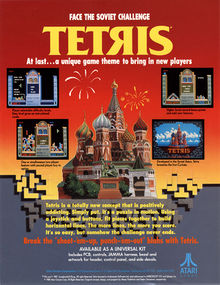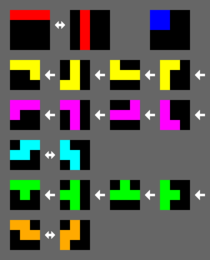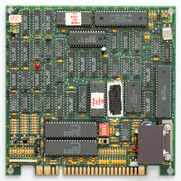Tetris (Atari): Difference between revisions
No edit summary |
|||
| Line 55: | Line 55: | ||
The rotation rules are identical to those of [[Tetris (NES, Tengen)|the game's NES port]], except the tetrominoes are colored differently, and they do not change color once they lock. In addition, the player can rotate the tetrominoes only counterclockwise (columns in order 0, 3, 2, 1). | The rotation rules are identical to those of [[Tetris (NES, Tengen)|the game's NES port]], except the tetrominoes are colored differently, and they do not change color once they lock. In addition, the player can rotate the tetrominoes only counterclockwise (columns in order 0, 3, 2, 1). | ||
Because basic rotation | Because basic rotation would fail when a piece is against the right wall, but not when the same piece is against the left wall, this game will wallkick one square to the left if basic rotation fails. If that fails the piece will not rotate. This allows for a few very unique wallkicks. | ||
<br clear="all"/> | <br clear="all"/> | ||
Revision as of 15:07, 8 April 2022
| Tetяis | |
|---|---|
 Arcade flyer | |
| Developer(s) | Atari Games |
| Publisher(s) | Atari Games |
| Platform(s) | Arcade |
| Release | February 1989 |
| Gameplay info | |
| Next pieces | 1 (one extra during line delay) |
| Playfield size | 10 × 20 |
| Hold piece | No |
| Hard drop | No |
| Rotation system | Atari |
Tetris is an arcade game published by Atari Games released in February 1989.[1]
Gameplay
The game is based around rounds. The player progresses by clearing the target line count for the current round. When the round ends, the playfield is cleared and the next round starts.
Scoring
Next to each player's score is a horizontal bar called the rainbow meter. Every four lines cleared adds 1 to the rainbow meter. If the player tops out and continues, the rainbow meter is set the way it was before the player added.
The score for each tetromino that the player places is d*min(r*(r + h),250), where
- d = 1 for normal gravity or 2 for soft drop when the tetromino lands
- r = the number of bars on the rainbow meter plus 1
- h = the row on which the tetromino was placed, minus 1 (0 = bottom)
| Line clear | Points |
|---|---|
| 1 (single) | 50 |
| 2 (double) | 150 |
| 3 (triple) | 400 |
| 4 (tetris) | 900 |
After finishing each round, the game awards a "BONUS FOR LOW PUZZLE" of up to 2100 points based on the number of empty rows above the highest block left in the playfield. The formula is 5*e*(e + 1), where e is the number of empty rows, which corresponds to 10 points for the first line, 20 points for the second line, 30 points for the third line, and so on, with 10 more points for each line.
In a two-player game, finishing the level before the other player gives a 2,000 point bonus. This bonus is awarded both for skill and for putting more money into the machine.
Rotation system

The rotation rules are identical to those of the game's NES port, except the tetrominoes are colored differently, and they do not change color once they lock. In addition, the player can rotate the tetrominoes only counterclockwise (columns in order 0, 3, 2, 1).
Because basic rotation would fail when a piece is against the right wall, but not when the same piece is against the left wall, this game will wallkick one square to the left if basic rotation fails. If that fails the piece will not rotate. This allows for a few very unique wallkicks.
Rounds
| Round | Lines required | Gimmick* | Notes |
|---|---|---|---|
| 1 | 5 | No gimmick | Easy mode starting round. |
| 2 | 10 | ||
| 3 | 12 | ||
| 4 | 10 | Starting configuration of blocks. | Normal mode starting round. Start with a column of 8 blocks on each side of the playfield. |
| 5 | 13 | Start with 10 blocks scattered across the bottom 5 rows. | |
| 6 | 16 | Start with blocks in a pyramid formation. | |
| 7 | 12 | Single blocks spawn on the field. Their appearance can be delayed by clearing lines. | Hard mode starting round. One block spawns on the surface of the stack every 8 pieces where no line is cleared. |
| 8 | 15 | One block spawns on the surface of the stack every 5 pieces where no line is cleared. | |
| 9 | 18 | One block spawns on the surface of the stack every 3 pieces where no line is cleared. | |
| 10 | 12 | Garbage appears on the field. | A row of garbage appears every 8 pieces. |
| 11 | 15 | A row of garbage appears every 6 pieces. | |
| 12 | 18 | A row of garbage appears every 3 pieces. | |
| 13 | 12 | Starting configuration of blocks. | Start with two triangles, one on each side |
| 14 | 15 | Start with six blocks, two each on rows 2, 4 and 6 from the bottom. | |
| 15 | 18 | Start with four diagonal lines of blocks. | |
| 16 | 12 | Starting configuration of blocks, based on high score initials. | Start with blocks forming the initials of the first high score. |
| 17 | 15 | Start with blocks forming the initials of the second high score. | |
| 18 | 18 | Start with blocks forming the initials of the third high score. | |
| 19 | 12 | Single blocks spawn with round 4-6 configurations. | Starting position from round 4, one block spawns on the surface of the stack every 8 pieces where no line is cleared. |
| 20 | 15 | Starting position from round 5, one block spawns on the surface of the stack every 6 pieces where no line is cleared. | |
| 21 | 18 | Starting position from round 6, one block spawns on the surface of the stack every 3 pieces where no line is cleared. | |
| 22 | 12 | Garbage spawns with round 4-6 configurations. | Starting position from round 4, a row of garbage appears every 8 pieces where no line is cleared. |
| 23 | 15 | Starting position from round 5, a row of garbage appears every 6 (?) pieces where no line is cleared. | |
| 24 | 18 | Starting position from round 6, a row of garbage appears every 3 pieces where no line is cleared. | |
| 25 | 12 | Single blocks and garbage spawn simultaneously. | A row of garbage appears and one block spawns on the surface of the stack every 8 pieces where no line is cleared. |
| 26 | 15 | A row of garbage appears and one block spawns on the surface of the stack every 6 pieces where no line is cleared. | |
| 27 | 18 | A row of garbage appears and one block spawns on the surface of the stack every 3 pieces where no line is cleared. |
* After round 27 gimmicks loop through rounds 16-27.
Trivia
- The game's platform did not support sprites. The whole game ran in "text" mode, just as many of the early PC versions of Tetris did.
- Except in copyright notices and in the name Vadim Gerasimov, all letter 'R's appeared as a Cyrillic letter Ya ('Я').
Physical scans
See also
References
- ↑ "Press release regarding litigation". atari email archive. April 18, 1989. Archived from the original on December 31, 2020. Retrieved December 31, 2020.


